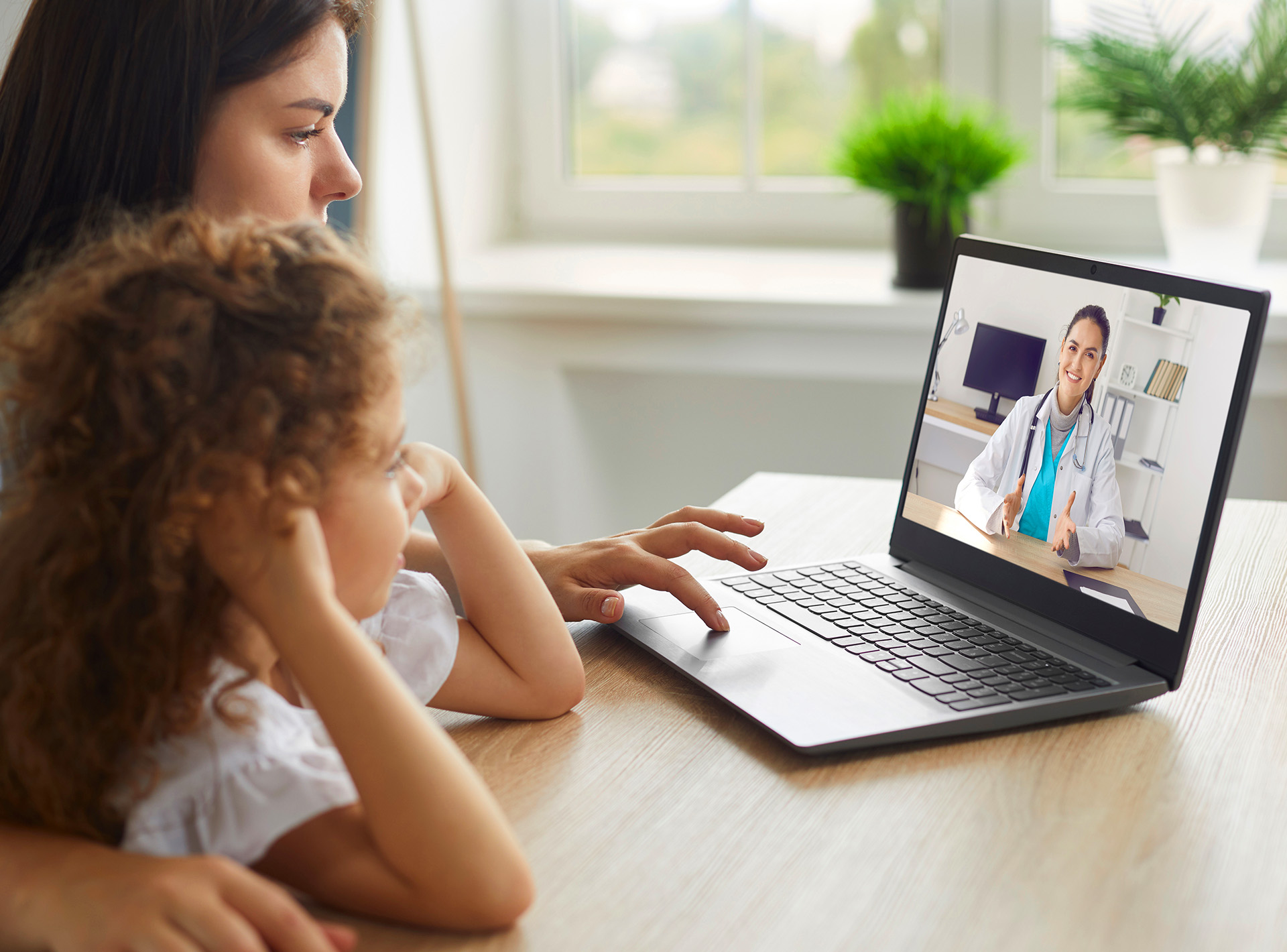Telehealth offers promising way to provide substance use disorder treatment during pregnancy

Although treatment for substance use disorders can be lifesaving for pregnant women and their babies, many prospective mothers struggle to find care. Millions of Americans live in “maternal health care deserts,” where there are no hospitals or health care providers who provide pregnancy-related care. Research suggests that telehealth may help to bridge this gap by eliminating some of the barriers that prevent pregnant women from seeing a medical provider, such as a lack of childcare and reliable transportation. Pregnant women who receive treatment for opioid use disorder are less likely to overdose, and their babies are more likely be born full term.

Although treatment for substance use disorder can be lifesaving for pregnant women, many struggle to find care (PDF, 763K).
Forty percent of U.S. counties have no opioid treatment centers. When facilities exist, only 29% offer specific programs for pregnant and postpartum women. Residents of rural areas—which tend to have higher rates of fatal overdoses than more urban regions—can face long drives to treatment clinics. Outpatient clinics that treat opioid use disorder are less likely to accept pregnant women (PDF, 763K) than other patients. And while obstetrician-gynecologists often screen patients for substance use disorder, few are comfortable treating it.
With so many barriers, it’s easy to understand why only 50% to 60% of pregnant women with opioid use disorder receive recommended medications (PDF, 520K) for the condition.
“It’s still far too hard to get opioid use disorder treatment when you’re pregnant,” said Dr. Stephen Patrick, chair of the Department of Health Policy and Management at Emory University’s Rollins School of Public Health.
Research suggests that providing substance use disorder treatment over telehealth can help. In a new study, researchers followed 94 pregnant women who used a telehealth app to undergo treatment for opioid use disorder. Women in the study could receive counseling as well as prescriptions for medications, including buprenorphine, one of two medications that are the standard of care for treating opioid use disorder during pregnancy.
Eighty percent of women stuck with treatment throughout pregnancy, according to the study, published in JAMA Network Open in March 2024. Twenty percent dropped out of treatment and couldn’t be contacted or left care because of financial reasons.
Among patients who continued care throughout pregnancy, 92% stayed with telehealth for their medications for opioid use disorder, while 8% transferred to prenatal clinics for their care.
Among those who continued telehealth visits through the end of pregnancy, 94% remained in care through 6 weeks after delivery, a stressful period when mothers are more likely to resume using opioids. Urine tests showed that everyone who remained in care after delivery continued to take buprenorphine as prescribed.
“The potential is there for telehealth to provide an easy way for individuals to get compassionate care that meets them where they are, without judgement,” said Marlene Lira, an epidemiologist and senior author of the new study.
“Retaining so many people in care is impressive,” said Dr. Kisha Davis, a board member of the American Academy of Family Physicians who wasn’t involved in the new study.
“Those are really encouraging numbers,” Davis said. “That really speaks to the power of telehealth for opioid use disorder. We should be opening all doors to substance use disorder treatment while you’re pregnant.”
Lira’s study was funded through a small business innovation research contract from the National Institute on Drug Abuse.
Although research shows that telehealth reduces overdoses and motivates patients to stay in treatment, relatively few studies have included or focused on pregnant women. When Lira began her research, she could find only one earlier study using telehealth to treat opioid use disorder in pregnancy. That study, published in JAMA Network Open in 2020, found that pregnant women were equally likely to remain in care for opioid use disorder whether they received virtual or in-person care.
Both telehealth studies in pregnant women were small. Authors acknowledge that other researchers will need to conduct larger clinical trials to find out if telehealth’s apparent advantages are real and can be repeated by other researchers.
Lira hopes that her findings will encourage additional research, noting that the use of telehealth for substance use treatment during pregnancy is understudied.
“There should be more than two studies,” said Lira, director of research at Workit Health in Ann Arbor, Michigan, which offers virtual substance use disorder treatment.
Taking care of moms and babies

“Helping pregnant women access buprenorphine is good for mothers and babies,” Davis said.
Studies show that buprenorphine reduces opioid cravings and lowers the risk that people will use illegal substances, such as heroin or fentanyl. Buprenorphine is considered safe for mothers and babies, both before birth and while breastfeeding. Pregnant women with opioid use disorder who take buprenorphine have lower risks of overdose and premature delivery compared to pregnant patients with an opioid use disorder who don’t take this medication.
“If we can just start with getting the medication to those who need it, if we can just do that, things start to get better,” Patrick said. “Taking care of mom is good for baby.”
Medications for opioid use disorder can reduce the danger of overdose and death in pregnant women, and reduce the risk that babies will be born early. Babies whose mothers receive these medications while pregnant are healthier and more likely to be born full term. So, they are more likely to be able to leave the hospital with their moms, instead of requiring lengthy stays in the neonatal intensive care unit.
“If we keep the mom treated, the mom is much more likely to be there to take care of that baby,” said Davis, who prescribes buprenorphine for her pregnant patients with opioid use disorder. “We’ve seen really great results."
Helping women avoid stigma – and long commutes.
Millions of Americans in rural areas live in “maternal health care deserts,” or counties without maternity care resources, obstetric care providers, or hospitals or birth centers offering obstetric care. Many rural areas lack any local hospital and face shortages of primary care doctors.
More than 100 rural hospitals have closed in the past decade. Nearly 700 additional rural medical centers—representing 30% percent of all rural hospitals in the United States—are at risk of closing, according to the Center for Healthcare Quality and Payment Reform.
Telehealth allows people to receive opioid use disorder treatment without making long trips. Even in large cities, people without private transportation often must take multiple buses to get to their closest hospital, even though it’s located only a few miles away.
“Telehealth also gives people additional privacy and flexibility,” Davis said. One of her pregnant patients attended 15-minute virtual visits during her work breaks; she logged in on her phone from her car.
“Telehealth offers additional benefits for people with children, who can stay home with their kids during virtual visits, rather than taking them along to appointments or finding childcare,” Lira said. “Some women even breastfeed during their virtual visits.”
In Lira’s study, women could receive mental health care and opioid use disorder treatment at the same time. More than half the women in her study had been diagnosed with depression or anxiety, and 15% suffered from post-traumatic stress disorder, or PTSD.
A study in JAMA Psychiatry found that telehealth helped to boost the percentage of adults receiving psychotherapy for mental distress from 6.5% in 2018 to 8.5% in 2021.
Telehealth also narrowed the gap in access to care between rural and urban residents who need substance use disorder treatment, according to a study in JAMA Network Open.
Yet challenges remain. People who live in areas without broadband service may be unable to connect to telehealth, however, even on their phones.
And telehealth isn't reaching patients who are the most financially vulnerable. In the mental health study, the greatest growth in telehealth was among college-educated people with higher incomes and private insurance. In the study of substance use disorder treatment, patients with private insurance or Medicare Advantage made up a disproportionate share of those using telehealth, compared to those insured by Medicaid, the joint federal-state program for people with low incomes or disabilities.
Lira notes that virtual visits can’t provide all the care that women need during pregnancy.
Although doctors can prescribe medications and order home drug tests through telehealth, pregnant women still need to see a health care provider for physical exams and procedures such as blood pressure checks.
“We know the limits of telemedicine,” Lira said. “We’re not going to treat a broken leg over Zoom.”
Filling an urgent need
The need to improve access to substance use disorder treatment has never been greater.
The fatal overdose rate among pregnant women nearly doubled from 2018 to 2021. Among those ages 35 to 44, the rate of overdose death tripled, according to a study from the National Institute on Drug Abuse, part of the National Institutes of Health.
Nearly 5% of pregnant women in 2023 reported using illicit drugs in the past month. From 2010 to 2017, the number of pregnant women who had an opioid-related diagnosis at delivery increased by 131%.
Using illegal drugs—or misusing legal ones—poses serious risks to mother and child.
Women with a diagnosis of opioid use disorder at the time of delivery are nearly five times more likely to die (PDF, 763K) while in the hospital. They are also 3.5 times more likely to have a cardiac arrest and twice as likely to give birth early, need a blood transfusion, suffer a stillbirth, or develop other serious pregnancy complications, compared to women without the diagnosis.
Substance use disorders are becoming major contributors to the county’s high rate of maternal mortality. In a recent study, 11% of pregnancy-related deaths were due to use of illegal or prescription drugs.
A time of hope
“Yet pregnancy is also a prime opportunity for women to make health changes in their lives,” said Dr. Cara Poland, an addiction medicine specialist who leads the GREAT Moms clinic in Grand Rapids, Michigan, which treats pregnant women with substance use disorders.
Expectant mothers tend to be highly motivated to give their child a healthy start in life.
“We all make behavioral changes when we’re pregnant,” Poland said. “I have yet to meet a pregnant woman who doesn’t change something about her lifestyle to have a healthy baby.”
Lira said she would like to conduct larger studies that follow moms for the first year after delivery, to measure whether telehealth can help women stay in recovery. “Some of the pregnant women who might be able to benefit the most from telehealth are in jails or prison, where they often get little to no substance use treatment,” she said.
“There are amazing opportunities for telehealth to meet the needs of populations that historically have had trouble getting care,” Lira said.
TOPIC WOMEN'S HEALTH | BY LIZ SZABO
Contact.
We love to meet like-minded people. Do you have a project you would like to chat about?